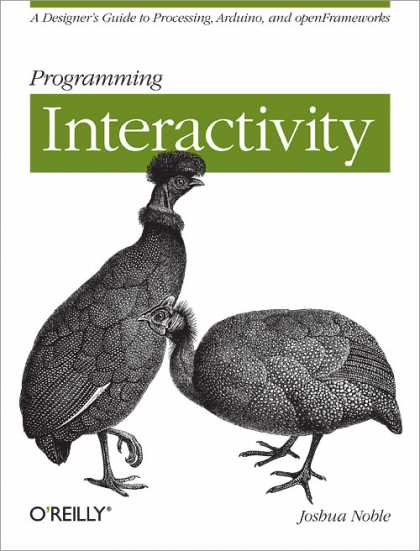Casey Reas, Ben Fry: Processing: A Programming Handbook for Visual Designers and Artists (2007)
Filed under manual | Tags: · art, code, computer animation, computer art, design, image, interactivity, open source, performance, processing, programming, software, typography

It has been more than twenty years since desktop publishing reinvented design, and it’s clear that there is a growing need for designers and artists to learn programming skills to fill the widening gap between their ideas and the capability of their purchased software. This book is an introduction to the concepts of computer programming within the context of the visual arts. It offers a comprehensive reference and text for Processing (www.processing.org), an open-source programming language that can be used by students, artists, designers, architects, researchers, and anyone who wants to program images, animation, and interactivity.
The ideas in Processing have been tested in classrooms, workshops, and arts institutions, including UCLA, Carnegie Mellon, New York University, and Harvard University. Tutorial units make up the bulk of the book and introduce the syntax and concepts of software (including variables, functions, and object-oriented programming), cover such topics as photography and drawing in relation to software, and feature many short, prototypical example programs with related images and explanations. More advanced professional projects from such domains as animation, performance, and typography are discussed in interviews with their creators. “Extensions” present concise introductions to further areas of investigation, including computer vision, sound, and electronics. Appendixes, references to other material, and a glossary contain additional technical details. Processing can be used by reading each unit in order, or by following each category from the beginning of the book to the end. The Processing software and all of the code presented can be downloaded and run for future exploration.
Essays by: Alexander R. Galloway, Golan Levin, R. Luke DuBois, Simon Greenwold, Francis Li, Hernando Barragán
Interviews with: Jared Tarbell, Martin Wattenberg, James Paterson, Erik van Blockland, Ed Burton, Josh On, Jürg Lehni, Auriea Harvey and Michaël Samyn, Mathew Cullen and Grady Hall, Bob Sabiston, Jennifer Steinkamp, Ruth Jarman and Joseph Gerhardt, Sue Costabile, Chris Csikszentmihályi, Golan Levin and Zachary Lieberman, Mark Hansen
Foreword by John Maeda
Publisher MIT Press, 2007
ISBN 0262182629, 9780262182621
Length 710 pages
project website
publisher
google books
PDF
All code examples in the book (ZIP)
Joshua Noble: Programming Interactivity: A Designer’s Guide to Processing, Arduino, and OpenFrameworks (2009)
Filed under manual | Tags: · arduino, human-computer interaction, interactivity, physical computing, processing

If you’re interested in using electronics and programming to create rich interactive experiences with your artwork, designs, or prototypes, “Programming Interactivity” is the place to start. You’ll explore common themes in interactive art and design, like 2D and 3D graphics, sound, physical interaction, computer vision, circuit bending, geo-location and more. This book explains programming and electrical engineering basics, and introduces three freely available tools created specifically for artists and designers:
- Processing, a Java-based programming language and environment for building projects on the desktop, Web, or mobile phones
- Arduino, a system that integrates a microcomputer prototyping board, IDE, and programming language for creating your own hardware and controls
- OpenFrameworks, a coding framework simplified for designers and artists, using the powerful C++ programming language
You’ll get working code samples you can use right away, along with the background and technical information you need to design, program, build, and troubleshoot your own projects. “Programming Interactivity” also examines cutting-edge design techniques, and includes discussions with leading artists and designers on projects and theory.
Publisher O’Reilly Media, Inc., 2009
ISBN 0596154143, 9780596154141
Length 768 pages
more info (gbooks)
programminginteractivity.com
preview
Tom Igoe: Making Things Talk: Practical Methods for Connecting Physical Objects (2007)
Filed under book, manual | Tags: · arduino, code, gps, hardware hacking, locative media, network art, physical computing, processing, rfid

Building electronic projects that interact with the physical world is good fun. But when devices that you’ve built start to talk to each other, things really start to get interesting. Through a series of simple projects, you’ll learn how to get your creations to communicate with one another by forming networks of smart devices that carry on conversations with you and your environment. Whether you need to plug some sensors in your home to the Internet or create a device that can interact wirelessly with other creations, Making Things Talk explains exactly what you need.
This book is perfect for people with little technical training but a lot of interest. Maybe you’re a science teacher who wants to show students how to monitor weather conditions at several locations at once, or a sculptor who wants to stage a room of choreographed mechanical sculptures. Making Things Talk demonstrates that once you figure out how objects communicate — whether they’re microcontroller-powered devices, email programs, or networked databases — you can get them to interact.
Each chapter in contains instructions on how to build working projects that help you do just that. You will:
* Make your pet’s bed send you email
* Make your own seesaw game controller that communicates over the Internet
* Learn how to use ZigBee and Bluetooth radios to transmit sensor data wirelessly
* Set up communication between microcontrollers, personal computers, and web servers using three easy-to-program, open source environments: Arduino/Wiring, Processing, and PHP.
* Write programs to send data across the Internet based on physical activity in your home, office, or backyard
* And much more
With a little electronics know-how, basic (not necessarily in BASIC) programming skills, a couple of inexpensive microcontroller kits and some network modules to make them communicate using Ethernet, ZigBee, and Bluetooth, you can get started on these projects right away. With Making Things Talk, the possibilities are practically endless.
Published by O’Reilly, 2007
ISBN 0596510519, 9780596510510
426 pages
Key terms:
serial port, Bluetooth, RFID, Digi-Key, ASCII, Mac OS X, Arduino, serial communication, telnet, ZigBee, personal computer, breadboard, HTTP, Ethernet, myFont, Linux, accelerometer, rssi, sensor, potentiometer
Review (we make money not art)
More info (publisher)
More info (google books)

